ignition BMW Z8 2000 Owners Manual
[x] Cancel search | Manufacturer: BMW, Model Year: 2000, Model line: Z8, Model: BMW Z8 2000Pages: 172, PDF Size: 1.9 MB
Page 9 of 172

Contents
Overview
Controls and features
Cockpit14
Instrument cluster16
Indicator and warning lamps18
Hazard warning flashers22
Warning triangle22
First-aid kit22
Refueling23
Fuel quality24
Tire inflation pressure24
Locks and security systems:
Keys28
Electronic vehicle
immobilizer29
Central locking system30
Opening and closing Ð from
outside30
Using the key30
Using the remote control31
Opening and closing Ð from
inside34
Luggage compartment lid35
Alarm system36
Electric power windows38
The automatic convertible
top39
Adjustments:
Seats43
Steering wheel45
Mirrors45
Car Memory, Key Memory46
Passenger safety systems:
Safety belts48
Airbags49
Child restraints51
Child seat safety52
Driving:
Steering/Ignition lock53
Starting the engine54
Turning the engine off54
Parking brake55
Manual transmission56
Turn signal indicator/Headlamp
flasher56
Wiper/Washer system57
Rear window defroster58
Cruise control59
Everything under control:
Odometer60
Tachometer60
Fuel gauge60
Coolant temperature gauge61
Service Interval Display61
Clock62
Multi-Information Radio (MIR)62
Technology for safety and
driving convenience:
Dynamic Stability Control
(DSC)63
Dynamic Driving Control64
Tire Pressure Warning (RDW)65
Contents
Page 28 of 172
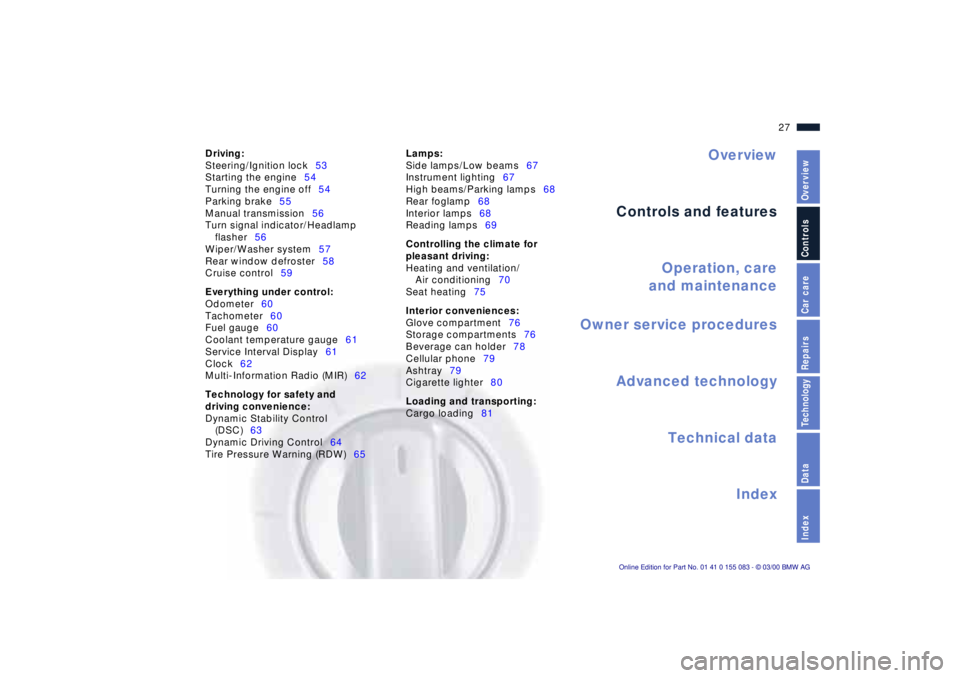
Overview
Controls and features
Operation, care
and maintenance
Owner service procedures
Technical data
Index Advanced technology
27n
IndexDataTechnologyRepairsCar careControlsOverview
Driving:
Steering/Ignition lock53
Starting the engine54
Turning the engine off54
Parking brake55
Manual transmission56
Turn signal indicator/Headlamp
flasher56
Wiper/Washer system57
Rear window defroster58
Cruise control59
Everything under control:
Odometer60
Tachometer60
Fuel gauge60
Coolant temperature gauge61
Service Interval Display61
Clock62
Multi-Information Radio (MIR)62
Technology for safety and
driving convenience:
Dynamic Stability Control
(DSC)63
Dynamic Driving Control64
Tire Pressure Warning (RDW)65Lamps:
Side lamps/Low beams67
Instrument lighting67
High beams/Parking lamps68
Rear foglamp68
Interior lamps68
Reading lamps69
Controlling the climate for
pleasant driving:
Heating and ventilation/
Air conditioning70
Seat heating75
Interior conveniences:
Glove compartment76
Storage compartments76
Beverage can holder78
Cellular phone79
Ashtray79
Cigarette lighter80
Loading and transporting:
Cargo loading81
Page 29 of 172
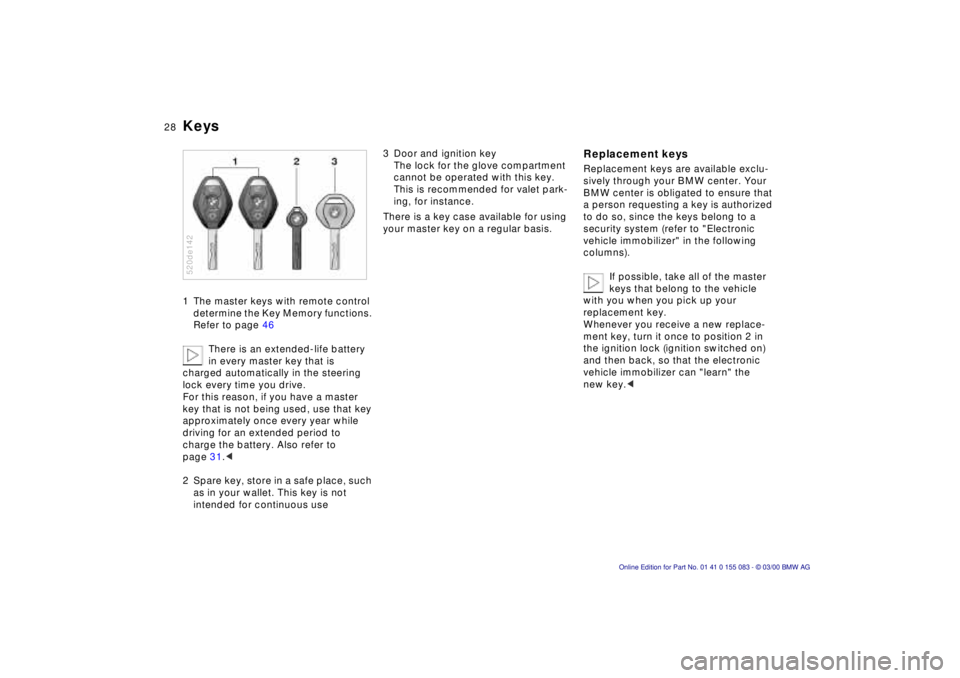
28n
Keys1 The master keys with remote control
determine the Key Memory functions.
Refer to page 46
There is an extended-life battery
in every master key that is
charged automatically in the steering
lock every time you drive.
For this reason, if you have a master
key that is not being used, use that key
approximately once every year while
driving for an extended period to
charge the battery. Also refer to
page 31.<
2 Spare key, store in a safe place, such
as in your wallet. This key is not
intended for continuous use 520de142
3 Door and ignition key
The lock for the glove compartment
cannot be operated with this key.
This is recommended for valet park-
ing, for instance.
There is a key case available for using
your master key on a regular basis.
Replacement keysReplacement keys are available exclu-
sively through your BMW center. Your
BMW center is obligated to ensure that
a person requesting a key is authorized
to do so, since the keys belong to a
security system (refer to "Electronic
vehicle immobilizer" in the following
columns).
If possible, take all of the master
keys that belong to the vehicle
with you when you pick up your
replacement key.
Whenever you receive a new replace-
ment key, turn it once to position 2 in
the ignition lock (ignition switched on)
and then back, so that the electronic
vehicle immobilizer can "learn" the
new key.<
Page 30 of 172
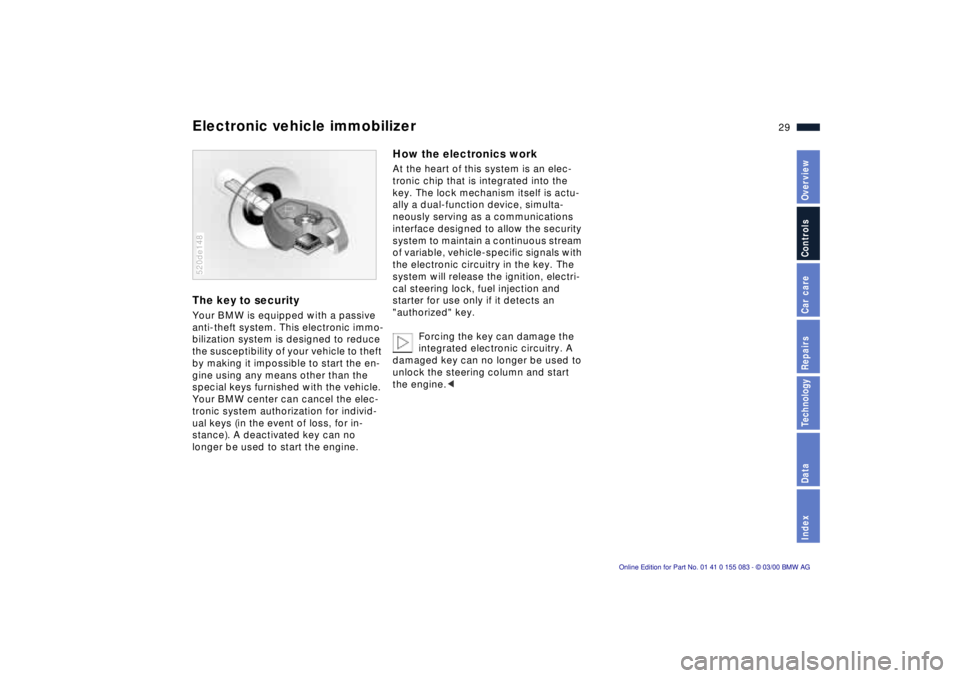
29n
IndexDataTechnologyRepairsCar careControlsOverview
Electronic vehicle immobilizer The key to securityYour BMW is equipped with a passive
anti-theft system. This electronic immo-
bilization system is designed to reduce
the susceptibility of your vehicle to theft
by making it impossible to start the en-
gine using any means other than the
special keys furnished with the vehicle.
Your BMW center can cancel the elec-
tronic system authorization for individ-
ual keys (in the event of loss, for in-
stance). A deactivated key can no
longer be used to start the engine.520de148
How the electronics workAt the heart of this system is an elec-
tronic chip that is integrated into the
key. The lock mechanism itself is actu-
ally a dual-function device, simulta-
neously serving as a communications
interface designed to allow the security
system to maintain a continuous stream
of variable, vehicle-specific signals with
the electronic circuitry in the key. The
system will release the ignition, electri-
cal steering lock, fuel injection and
starter for use only if it detects an
"authorized" key.
Forcing the key can damage the
integrated electronic circuitry. A
damaged key can no longer be used to
unlock the steering column and start
the engine.<
Page 32 of 172

31n
IndexDataTechnologyRepairsCar careControlsOverview
Opening and closing Ð from outsideUsing the remote control The remote control gives you an excep-
tionally convenient method for unlock-
ing and locking your vehicle. Further-
more, it provides three additional
functions that you can only execute by
means of the remote control:
>Switch on the interior lamps
With this function, you can also
"search for" your vehicle Ñ if, for
example, it is parked in an under-
ground garage
>Open the luggage compartment lid
>Panic Mode
In case of danger, you can trigger
an alarm.
The anti-theft system is also deacti-
vated/activated simultaneously with the
unlocking or locking of the vehicle, and
the alarm system is disarmed/armed,
and the interior lamps are turned on/off.
Master keysKeys with remote control are master
keys. Refer to page 28.
You can have various signals set
as an acknowledgment message
when locking.<
Children might be able to lock the
doors from the inside. For this rea-
son, always take the vehicle keys with
you so that the vehicle can be opened
again from the outside at any time.<520de010
Master keys that are used repeat-
edly are always ready for opera-
tion since the battery in the key is
charged automatically in the steering
lock every time you drive.
If it is no longer possible to unlock the
vehicle via the remote control, the bat-
tery is discharged. Use this key while
driving for an extended period in order
to charge the battery. Refer also to
page 28.
To prevent unauthorized use of the
remote control, surrender only the door
and ignition key 3 or the spare key 2
(refer to page 28) when leaving the
vehicle for valet parking, for example.
In the event of a system malfunction,
please contact your BMW center. You
can also obtain replacement keys
there.<
Page 39 of 172

38n
Electric power windowsTo open and close the windowsFrom ignition key position 1:
>Press the switch up to but not past
the pressure point:
As long as you continue to hold the
switch down, the window will either
lower or raise
>Press the switch briefly past the pres-
sure point:
The window moves automatically.
Tapping it again stops the opening
or closing action.
The window on the passenger
side cannot be closed with the
one-touch mode function.<520de015
Using switch number 2, you determine
which window is to be opened or
closed:
>Window on the driver side,
push the switch all the way to the left
>Window on the passenger side,
push the switch all the way to the
right
>To move both windows at the same
time, keep the switch in the center
position.
The switch on the passenger-side door
activates the window for that side
alone.
After the ignition has been switched off:
You can still operate the electric win-
dows for up to 15 minutes, provided
that no door has been opened. Because the power windows are
sealed at high pressure to prevent
wind noise when closed, a powerful
motor is required for efficient closing.
When closing the windows, always
ensure that they are not obstructed in
any way. Unsupervised use of these
systems can result in serious personal
injury. Remove the ignition key to deac-
tivate the electric power windows when-
ever you leave the vehicle. Never leave
the keys in the vehicle with unsuper-
vised children.
Never place anything that could obstruct
the driver's vision on or next to the
windows.<
To use the convenience mode via the
door lock or the remote control, refer to
pages 30 or 32.
Page 40 of 172
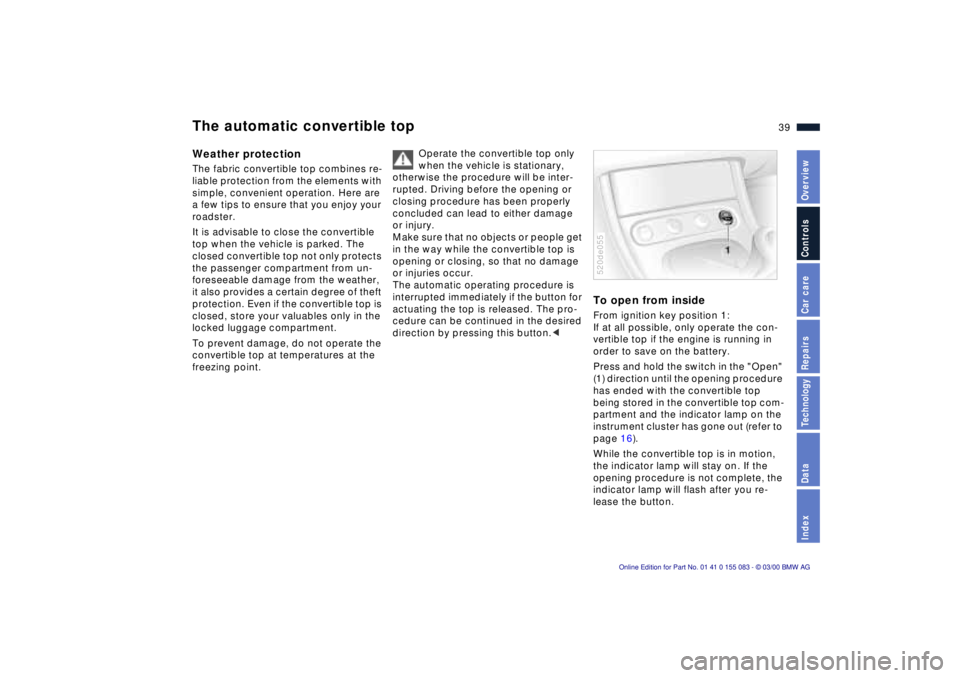
39n
IndexDataTechnologyRepairsCar careControlsOverview
The automatic convertible topWeather protectionThe fabric convertible top combines re-
liable protection from the elements with
simple, convenient operation. Here are
a few tips to ensure that you enjoy your
roadster.
It is advisable to close the convertible
top when the vehicle is parked. The
closed convertible top not only protects
the passenger compartment from un-
foreseeable damage from the weather,
it also provides a certain degree of theft
protection. Even if the convertible top is
closed, store your valuables only in the
locked luggage compartment.
To prevent damage, do not operate the
convertible top at temperatures at the
freezing point.Operate the convertible top only
when the vehicle is stationary,
otherwise the procedure will be inter-
rupted. Driving before the opening or
closing procedure has been properly
concluded can lead to either damage
or injury.
Make sure that no objects or people get
in the way while the convertible top is
opening or closing, so that no damage
or injuries occur.
The automatic operating procedure is
interrupted immediately if the button for
actuating the top is released. The pro-
cedure can be continued in the desired
direction by pressing this button.<
To open from insideFrom ignition key position 1:
If at all possible, only operate the con-
vertible top if the engine is running in
order to save on the battery.
Press and hold the switch in the "Open"
(1) direction until the opening procedure
has ended with the convertible top
being stored in the convertible top com-
partment and the indicator lamp on the
instrument cluster has gone out (refer to
page 16).
While the convertible top is in motion,
the indicator lamp will stay on. If the
opening procedure is not complete, the
indicator lamp will flash after you re-
lease the button.520de055
Page 46 of 172
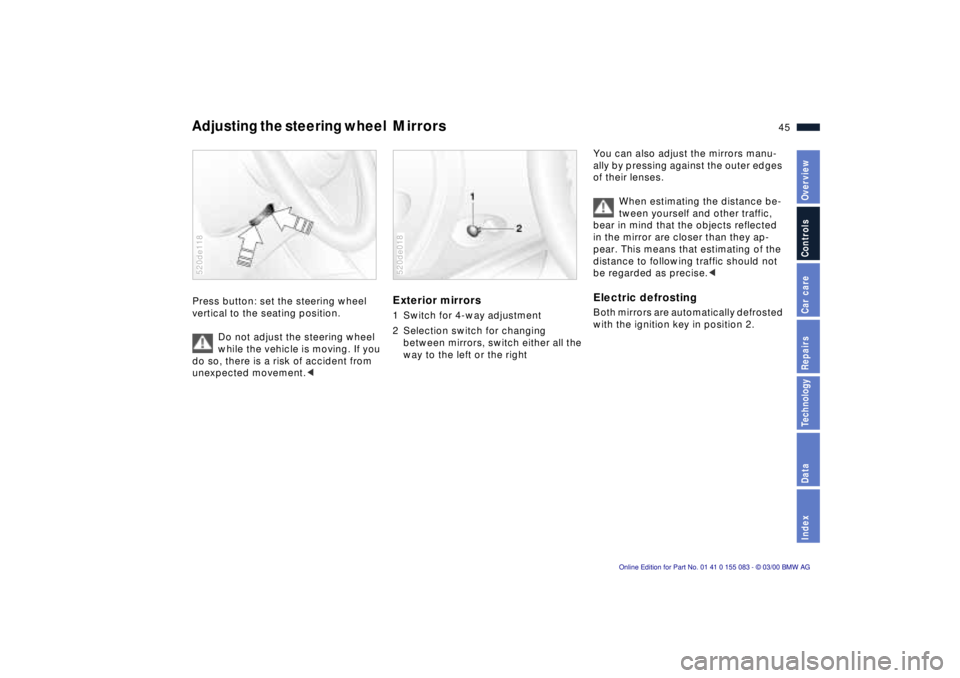
45n
IndexDataTechnologyRepairsCar careControlsOverview
Adjusting the steering wheel
Mirrors
Press button: set the steering wheel
vertical to the seating position.
Do not adjust the steering wheel
while the vehicle is moving. If you
do so, there is a risk of accident from
unexpected movement.<520de118
Exterior mirrors1 Switch for 4-way adjustment
2 Selection switch for changing
between mirrors, switch either all the
way to the left or the right 520de018
You can also adjust the mirrors manu-
ally by pressing against the outer edges
of their lenses.
When estimating the distance be-
tween yourself and other traffic,
bear in mind that the objects reflected
in the mirror are closer than they ap-
pear. This means that estimating of the
distance to following traffic should not
be regarded as precise.
Page 50 of 172

49n
IndexDataTechnologyRepairsCar careControlsOverview
Airbags 1 Front airbag for driver and passenger
2 Side airbagsProtective effectIn addition to the three-point safety
belts, the front airbags provide addi-
tional protection, in case safety belts
are not enough in a severe frontal
impact. The side airbags help provide
protection in the event of a collision
from the side. Each of the side airbags
is designed to help support the seat
occupant's upper body.520de021
The illustration depicts schematically
the primary directions of vehicle impact
that initiate airbag deployment.520de022
Indicator lamp
The indicator lamp displays the
operational status of the airbag
system from ignition key posi-
tion 1 and on.
System operational:
>The indicator lamp comes on briefly
then goes out.
System malfunction:
>The indicator lamp fails to come on
>The indicator lamp comes on briefly
before going out and then lighting up
again.
If the system malfunctions, there is the
danger that the airbags will not be trig-
gered within their response range dur-
ing an accident, even if the level of
impact would normally have triggered
them.
Have your BMW center inspect the
system immediately.
Page 51 of 172
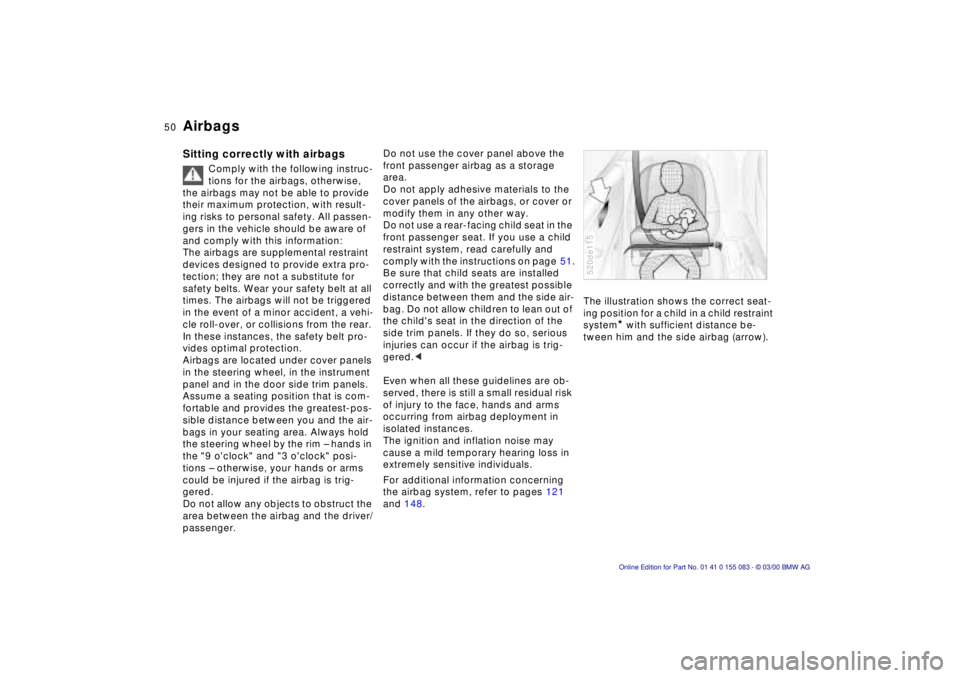
50n
AirbagsSitting correctly with airbags
Comply with the following instruc-
tions for the airbags, otherwise,
the airbags may not be able to provide
their maximum protection, with result-
ing risks to personal safety. All passen-
gers in the vehicle should be aware of
and comply with this information:
The airbags are supplemental restraint
devices designed to provide extra pro-
tection; they are not a substitute for
safety belts. Wear your safety belt at all
times. The airbags will not be triggered
in the event of a minor accident, a vehi-
cle roll-over, or collisions from the rear.
In these instances, the safety belt pro-
vides optimal protection.
Airbags are located under cover panels
in the steering wheel, in the instrument
panel and in the door side trim panels.
Assume a seating position that is com-
fortable and provides the greatest-pos-
sible distance between you and the air-
bags in your seating area. Always hold
the steering wheel by the rim Ð hands in
the "9 o'clock" and "3 o'clock" posi-
tions Ð otherwise, your hands or arms
could be injured if the airbag is trig-
gered.
Do not allow any objects to obstruct the
area between the airbag and the driver/
passenger.
Do not use the cover panel above the
front passenger airbag as a storage
area.
Do not apply adhesive materials to the
cover panels of the airbags, or cover or
modify them in any other way.
Do not use a rear-facing child seat in the
front passenger seat. If you use a child
restraint system, read carefully and
comply with the instructions on page 51.
Be sure that child seats are installed
correctly and with the greatest possible
distance between them and the side air-
bag. Do not allow children to lean out of
the child's seat in the direction of the
side trim panels. If they do so, serious
injuries can occur if the airbag is trig-
gered.<
Even when all these guidelines are ob-
served, there is still a small residual risk
of injury to the face, hands and arms
occurring from airbag deployment in
isolated instances.
The ignition and inflation noise may
cause a mild temporary hearing loss in
extremely sensitive individuals.
For additional information concerning
the airbag system, refer to pages 121
and 148.The illustration shows the correct seat-
ing position for a child in a child restraint
system
* with sufficient distance be-
tween him and the side airbag (arrow).
520de115